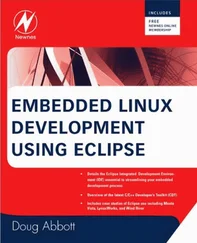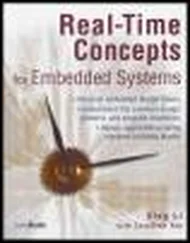ppc_md.halt = mpc52xx_halt;
/* No time keeper on the LITE5200 */
ppc_md.time_init = NULL;
ppc_md.get_rtc_time = NULL;
ppc_md.set_rtc_time = NULL;
ppc_md.calibrate_decr = mpc52xx_calibrate_decr;
#ifdef CONFIG_SERIAL_TEXT_DEBUG
ppc_md.progress = mpc52xx_progress;
#endif
}
This function contains much of the customizing that is required for this particular platform. It starts by searching for board-specific data supplied by the bootloader. We defer discussion of the details of this until Section 16.3.2, "Board Information Structure."
Following this, if your kernel is configured for an initial ramdisk (initrd) [110] The initial ramdisk, or initrd, was introduced in Chapter 6.
, the start and end addresses of the ramdisk image are saved. Notice that they are passed in the PowerPC general-purpose registers r4 and r5 by convention. It is the bootloader's responsibility to pass the initrd addresses in these registers. Later, the kernel will use these addresses to load the initrd image from raw memory (where the bootloader placed it, or a nonvolatile Flash image) into an internal kernel ramdisk structure.
Next we see code to store the kernel command line, whose address is passed into platform_init() via registers r6 and r7, marking the start and end addresses, respectively. This differs from the method described earlier for storing a static kernel command line in one specific detail: this kernel command line was passed to platform_init() from the bootloader, as opposed to being compiled into the kernel.
Copying the initrd and kernel command line is very straightforward. Basically, the registers passed in from the bootloader contain the memory addresses where these data structures reside. There is one minor subtlety, however. You may have already wondered about the purpose of the constant KERNELBASE. Understanding this is key to grasping one of the more complex parts of the boot sequence.
The addresses the bootloader provides are physical addresses. This means they are the real hardware addresses where the data resides in the memory chips. The bootloader typically operates without support for virtual memory. However, the kernel itself is statically linked to a well-known, user-configured base address. This address is KERNELBASE. (The value itself is not relevant to the discussionit is user configurable but virtually never changed from its default value of 0xC0000000.)
This sets up an interesting situation in head.S. When the kernel is decompressed and relocated to RAM (usually to location 0), all of its code and data symbols are linked at the kernel's virtual address, KERNELBASE. This can be seen by examining the kernel symbol map file, produced during the kernel build process, System.map. [111] We introduced the System.map file in Chapter 4.
However, the execution context prior to enabling the MMU is such that physical addresses are real hardware addresses. This means that all the code prior to enabling the MMU and virtual memory mapping must be relocatable, and access to symbols must be fixed up . This involves adding an offset to the symbol's address to access it. An example will make this clear.
16.3.1. Early Variable Access
Let's assume that a code segment very early in the boot process needs to access the variable cmd_line so early that we're executing in 1:1 real to physical mapping. As pointed out earlier, this variable is defined in head.S and will end up in the .data section when the kernel is linked. From the Linux kernel's System.map file, you can find the linked addresses for cmd_line :
$ cat System.map | grep cmd_line
c0115000 D cmd_line
If we were running in real = physical mode (MMU disabled) and accessed this variable using its symbol, we would be trying to read or write to an address greater than 3GB. Most smaller embedded systems don't have any RAM in this region, and the results would be undefined or would result in a crash. Even if we had physical RAM at that address, it is unlikely that it would be mapped and accessible this early in the boot process. So we have to adjust our reference to this variable to access it.
Listing 16-9 reproduces a code snippet from head.S that does just that.
Listing 16-9. Variable Reference Fixup
relocate_kernel:
addis r9,r26,klimit@ha /* fetch klimit */
lwz r25,klimit@l(r9)
addis r25,r25,-KERNELBASE@h
This code snippet from the PowerPC head.S is a good example of the issue we are describing. The variable klimit represents the end of the kernel image. It is defined elsewhere as char *klimit. Therefore, it is a pointerit is an address that contains an address. In Listing 16-9, we fetch the address of klimit, sum it with a previously calculated offset that is passed in r26, and deposit the resulting value in register r9. Register r9 now contains the high-order 16 bits of the adjusted address of klimit, with the low-order bits zeroed. [112] For details of PPC assembly language syntax, see Section 16.5.1, "Suggestions for Additional Reading" at the end of this chapter.
It was adjusted by the offset value previously calculated and passed in register r26.
In the next line, the lwz instruction uses register r9 together with the offset of klimit (the lower 16 bits of the klimit address) as an effective address from which to load register r25. (Remember, klimit is a pointer, and we are interested in the value that klimit points to.) Register r25 now holds the pointer that was stored in the variable klimit. In the final line of Listing 16-9, we subtract the kernel's linked base address (KERNELBASE) from r25 to adjust the pointer to our actual physical address. In C, it would look like this:
unsigned int *tmp; /* represents r25 */
tmp = *klimit;
tmp -= KERNELBASE;
In summary, we referenced a pointer stored in klimit and adjusted its value to our real (physical) address so we can use its contents. When the kernel enables the MMU and virtual addressing, we no longer have to worry about thisthe kernel will be running at the address where it was linked, regardless of where in physical memory it is actually located.
16.3.2. Board Information Structure
Many bootloaders are used for PowerPC platforms, but there is still no unified way to pass in board-specific data such as serial port baud rate, memory size, and other low-level hardware parameters that the bootloader has configured. The platform-initialization file from Listing 16-8 supports two different methods, data stored as struct bi_record and data stored as struct bd_info. [113] Each method has its own roots. The struct bd_info originated in U-Boot, and struct bi_record was an attempt to unify across all platforms. Both are supported by many platforms.
Both methods provide similar results: hardware-specific data is passed from the bootloader to the kernel in these structures.
From Listing 16-8, here is the code snippet that saves the bootloader-supplied hardware configuration:
struct bi_record *bootinfo = find_bootinfo();
if (bootinfo) parse_bootinfo(bootinfo);
else {
/* Load the bd_t board info structure */
if (r3) memcpy((void*)&__res,(void*)(r3+KERNELBASE), sizeof(bd_t));
First, we search for a special tag that identifies the data structure as a struct bi_record. If that is found, the bootinfo pointer is set to the address of the start of the bootinfo records. From there, the records are parsed and the hardware related data is gathered. This can be seen by inspecting .../arch/ppc/kernel/setup.c. Currently, bi_records can contain the kernel command line, the start and end address of the initrd image, the machine type, and the size of the memory. Of course, you can extend this for your own requirements.
Читать дальше












